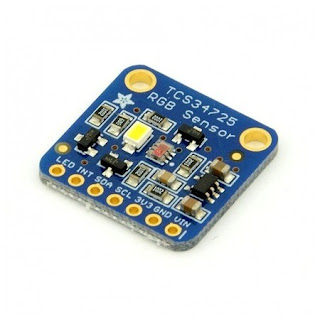Sensor de cor RGB TCS34725
/* Este código serve para usar dois sensores de cor RGB no mesmo Arduino em outras portas que não sejam as de padrão SDA SDL. Créditos a equipe Alpha Robot do LIA - Laboratório de Inteligência Artificial. IFAC - Campus Tarauacá*/
#include <Wire.h>
#include "Adafruit_TCS34725softi2c.h"
// You can use any digital pin for emulate SDA / SCL
#define SDApin_1 15
#define SCLpin_1 14
#define SDApin_2 19
#define SCLpin_2 18
// for a common anode LED, connect the common pin to +5V
// for common cathode, connect the common to ground
// set to false if using a common cathode LED
#define commonAnode_1 true
#define commonAnode_2 true
// our RGB -> eye-recognized gamma color
byte gammatable_1[256];
byte gammatable_2[256];
Adafruit_TCS34725softi2c tcs_1 = Adafruit_TCS34725softi2c(TCS34725_INTEGRATIONTIME_50MS, TCS34725_GAIN_4X, SDApin_1, SCLpin_1);
Adafruit_TCS34725softi2c tcs_2 = Adafruit_TCS34725softi2c(TCS34725_INTEGRATIONTIME_50MS, TCS34725_GAIN_4X, SDApin_2, SCLpin_2);
void setup() {
Serial.begin(9600);
Serial.println("Color View Test!");
if (tcs_1.begin()) {
Serial.println("Found sensor 1");
} else {
Serial.println("No TCS34725 (numero 1) found ... check your connections");
while (1); // halt!
}
if (tcs_2.begin()) {
Serial.println("Found sensor 2");
} else {
Serial.println("No TCS34725 (numero 2) found ... check your connections");
while (1); // halt!
}
// use these three pins to drive an LED
// thanks PhilB for this gamma table!
// it helps convert RGB colors to what humans see
for (int i=0; i<256; i++) {
float x = i;
x /= 255;
x = pow(x, 2.5);
x *= 255;
if (commonAnode_1) {
gammatable_1[i] = 255 - x;
} else {
gammatable_1[i] = x;
}
}
for (int i=0; i<256; i++) {
float x = i;
x /= 255;
x = pow(x, 2.5);
x *= 255;
if (commonAnode_2) {
gammatable_2[i] = 255 - x;
} else {
gammatable_2[i] = x;
}
}
//Serial.println(gammatable[i]);
}
void loop()
{
uint16_t clear, red_1,green_1, blue_1;
uint16_t red_2,green_2, blue_2;
tcs_1.setInterrupt(false); // turn on LED
tcs_2.setInterrupt(false); // turn on LED
delay(60); // takes 50ms to read
tcs_1.getRawData(&red_1, &green_1, &blue_1, &clear);
tcs_2.getRawData(&red_2, &green_2, &blue_2, &clear);
tcs_1.setInterrupt(true); // turn off LED
tcs_2.setInterrupt(true); // turn off LED
Serial.print("\tG(1):\t"); Serial.print(green_1);
Serial.println();
Serial.print("\tG(2):\t"); Serial.print(green_2);
Serial.println();
delay(500);
}

como baixar a biblioteca "Adafruit_TCS34725softi2c.h"?
ResponderExcluir